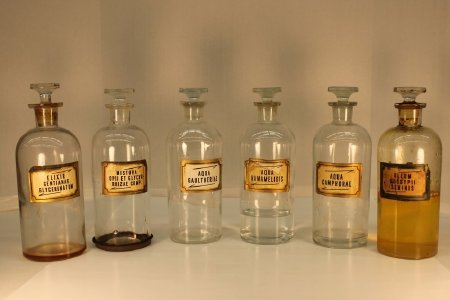Object ID Number:
PH119
Object Name:
Bottles
Type:
Shop Furniture
Manufactured from:
1888
Manufactured to:
1915
Description / History:
This collection contains 6 large pharmacy bottles. These bottles were manufactured by T.C. Wheaton & Co. in Millville, New Jersey in the late 1800s (1888 was first year of manufacture) – this is known because on the bottom of the bottles is the engraved name of the company "TCW–Co U.S.A." Each of the bottles also contain a label naming the original contents. The label also has a black and gold border and a black design surrounding the font. Below is a brief description of each bottle and their original contents.
Bottle A: Bottle A contains a label reading "Aqua Camphorae" the Latin word camphor water. Camphor water is used by inhaling the water and used to prevent cough. Camphor had many other uses in the earlier 1800s such as stimulant which would cause seizures which they believed would cure schizophrenia. Today, camphor is not allowed to be swallowed because it may cause death. However, camphor is found in ointments today to stimulate nerve endings and relieve pain and itching. There is a small amount of the camphor water remaining. It is a clear liquid.
Bottle B: Bottle B contains a label reading "Mistura Opii Et Glycyrrhizae Comp." which is Latin for Compound Licorice mixture. This mixture can be combined with other ingredients to act as an expectorant clearing mucus from the airways and getting rid of a cough.
Bottle C: Bottle C contains a label reading "Elixir Gentianae Glycerinatum." Gentianae is a root which original use was stimulate appetite. Today it is an active ingredient in medicines targeting yeast infections. There is a small amount of the gentianae remaining. It is a orange liquid.
Bottle D: Bottle D contains a label reading "Oleum Gossypii Seminis," also known as cotton seed oil. Cotton seed was first brought into the world of medicine in 1768 when Dr. William Otto used it to cure newborns of colic. Since then cottonseed oil has been used as a solvent for other medicines, a healing ointment to relieve pain and itching, and an ingredient in many herbal remedies. Today, cottonseed oil is used in the industry, farming, but most of all as a product in our food. It is a very common oil used to cook with and is also found in many dressings and spreads. The bottle is approximately halfway full with a yellow oil.
Bottle E: Bottle E has a label reading "Aqua Hamamelidis" which is witch hazel water in Latin. Witch hazel water is an astringent which constricts body tissue. It is often applied directly to skin to treat a variety of diseases like eczema, psorosis, and in–grown toenails. There is about a quarter of clear liquid left in the bottle.
Bottle F: Bottle F contains a label reading "Aqua Gaultheriae" which is a solution of water mixed with leaves of Gaultheria procombens (also known as wintergreen, teaberry, mountain tea, or boxberry). Externally, it is used to relieve toothaches and arthritis. It is used internally to relieve inflammation and irritation of the urino–genital tract. When combined with oil instead of water, Gaultheria procombens can cause vomiting. There are no contents left in the bottle.
Bottle A: Bottle A contains a label reading "Aqua Camphorae" the Latin word camphor water. Camphor water is used by inhaling the water and used to prevent cough. Camphor had many other uses in the earlier 1800s such as stimulant which would cause seizures which they believed would cure schizophrenia. Today, camphor is not allowed to be swallowed because it may cause death. However, camphor is found in ointments today to stimulate nerve endings and relieve pain and itching. There is a small amount of the camphor water remaining. It is a clear liquid.
Bottle B: Bottle B contains a label reading "Mistura Opii Et Glycyrrhizae Comp." which is Latin for Compound Licorice mixture. This mixture can be combined with other ingredients to act as an expectorant clearing mucus from the airways and getting rid of a cough.
Bottle C: Bottle C contains a label reading "Elixir Gentianae Glycerinatum." Gentianae is a root which original use was stimulate appetite. Today it is an active ingredient in medicines targeting yeast infections. There is a small amount of the gentianae remaining. It is a orange liquid.
Bottle D: Bottle D contains a label reading "Oleum Gossypii Seminis," also known as cotton seed oil. Cotton seed was first brought into the world of medicine in 1768 when Dr. William Otto used it to cure newborns of colic. Since then cottonseed oil has been used as a solvent for other medicines, a healing ointment to relieve pain and itching, and an ingredient in many herbal remedies. Today, cottonseed oil is used in the industry, farming, but most of all as a product in our food. It is a very common oil used to cook with and is also found in many dressings and spreads. The bottle is approximately halfway full with a yellow oil.
Bottle E: Bottle E has a label reading "Aqua Hamamelidis" which is witch hazel water in Latin. Witch hazel water is an astringent which constricts body tissue. It is often applied directly to skin to treat a variety of diseases like eczema, psorosis, and in–grown toenails. There is about a quarter of clear liquid left in the bottle.
Bottle F: Bottle F contains a label reading "Aqua Gaultheriae" which is a solution of water mixed with leaves of Gaultheria procombens (also known as wintergreen, teaberry, mountain tea, or boxberry). Externally, it is used to relieve toothaches and arthritis. It is used internally to relieve inflammation and irritation of the urino–genital tract. When combined with oil instead of water, Gaultheria procombens can cause vomiting. There are no contents left in the bottle.
Dimensions:
H–10 Dia–3.5 inches
